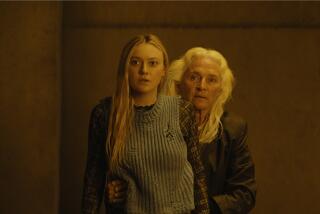Review: ‘Samsara’ is a frustrating beauty
“Samsara” is as frustrating as it is beautiful, which is saying a lot because this is a film laced with exquisite images.
Director and cinematographer Ron Fricke and his producer and co-editor Mark Magidson dragged their cumbersome 65-millimeter cameras to some of the remotest areas of the world, hitting 100 locations in 25 countries over a five-year period.
In one instance, they spent four hours hiking in and out of a Native American ruin in Arizona called Betatakin to film what turned out to be about eight seconds of screen time.
The results, as in the previous films Fricke has photographed, including “Baraka,” “Chronos” and “Koyaanisqatsi,” can take your breath away. There are aerial shots of the temple complex at Pagan in Myanmar, views of an elaborate sand painting being created at a Tibetan monastery in Ladakh in India, even some time-lapse photography of the venerable Los Angeles freeways that is stunning.
“Samsara” is apparently a Sanskrit word referring to what the film’s press material calls “the ever turning wheel of life,” the cycle of birth, death and rebirth that is central to many Asian religions.
The idea behind this film, as with the others Fricke has photographed, is to offer what he calls a guided meditation that encourages you to contemplate what a strange and beautiful place the world actually is.
In a simpler time, movies like this were called head trips, and though they can still function that way if you are so inclined, there are several factors that mitigate against complete enjoyment.
Unless you are stoned when you go to see “Samsara,” those possessing ordinary human curiosity are likely going to want to know what it is they are looking at. This is a pleasure, however, the film tries its best to deny you.
Operating on the principle that the image is all that matters, “Samsara” refuses to let us know what we are seeing. Yes, the closing credits function as a kind of square-up reel, listing all the locations, but the names go by too fast and come too late to offer any real help.
Some places, like Burma’s Pagan or Jordan’s Petra or the ancient Kaaba in Mecca, are so familiar we know them immediately, and we take the same kind of pleasure in their presence as we would at glimpsing a friendly face at a glamorous cocktail party where we’re not sure we belong.
Other places are equally fascinating, but to find out where they are you have to do research on the film’s website, where you discover, with the help of the Internet, that the exploding volcano visible in the opening minutes is in Kilauea, Hawaii, and those amazing oversize stone heads are remains of a 1st century BC tomb located in Mt. Nemrut National Park in Adiyaman, Turkey.
Sometimes finding the locations requires detective work worthy of Sherlock Holmes. A Google search of the initials CPDR that appear on the shirts worn by men at dance reveals the existence of the Cebu Provincial Detention and Rehabilitation Center, a maximum security institution in the Philippines that specializes in mass inmate dancing. The filmmakers might say that knowing this is immaterial, but then they already know, don’t they?
Another difficulty, especially for people looking to “Samsara” as a way to bliss out, is that more of the film’s images are disconcerting than one might expect. Included for our viewing are shots of a grossly overweight man being prepped for surgery as well as a glimpse of the disturbing performance art of Frenchman Olivier de Sagazan. There are images in “Samsara” you will be happy to remember and others you would like to forget.
Also problematic is the thinking behind the filmmaking. Some of the connections made are too obvious, like following images of ammunition with a portrait of a severely wounded veteran, while others are completely elusive. Shots of the devastation Katrina left behind in New Orleans are beautifully spooky, but does it say anything useful to follow that with images of Versailles? The makers of “Samsara” want to free our minds, but their technique makes us their prisoners more often than not.
---
MPAA rating: PG-13 for some disturbing and sexual images
Running time: 1 hour, 39 minutes
Playing: At selected theaters
PHOTOS AND MORE:
PHOTOS: Hollywood back lot moments
Latest movie reviews
PHOTOS: NC-17 movies: Why they got the rating
More to Read
Only good movies
Get the Indie Focus newsletter, Mark Olsen's weekly guide to the world of cinema.
You may occasionally receive promotional content from the Los Angeles Times.











